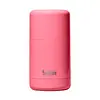What's inside
What's inside
 Key Ingredients
Key Ingredients

 Benefits
Benefits

 Concerns
Concerns

 Ingredients Side-by-side
Ingredients Side-by-side

Caprylic/Capric Triglyceride
MaskingOzokerite
Emulsion StabilisingMaranta Arundinacea Root Powder
Skin ConditioningParfum
MaskingZinc Ricinoleate
Salicylic Acid
MaskingAscophyllum Nodosum Extract
Skin ConditioningLaminaria Digitata Extract
Skin ProtectingCalophyllum Inophyllum Seed Oil
AntimicrobialSaccharomyces Ferment
Skin ConditioningLauroyl Lysine
Skin ConditioningGlycerin
HumectantCocos Nucifera Oil
MaskingButyrospermum Parkii Butter
Skin ConditioningLimonene
PerfumingCoumarin
PerfumingHexyl Cinnamal
PerfumingCaprylic/Capric Triglyceride, Ozokerite, Maranta Arundinacea Root Powder, Parfum, Zinc Ricinoleate, Salicylic Acid, Ascophyllum Nodosum Extract, Laminaria Digitata Extract, Calophyllum Inophyllum Seed Oil, Saccharomyces Ferment, Lauroyl Lysine, Glycerin, Cocos Nucifera Oil, Butyrospermum Parkii Butter, Limonene, Coumarin, Hexyl Cinnamal
Cocos Nucifera Oil
MaskingCaprylic/Capric Triglyceride
MaskingTapioca Starch
Stearyl Alcohol
EmollientMagnesium Hydroxide
AbsorbentHydrogenated Castor Oil
EmollientTriethyl Citrate
MaskingParfum
MaskingOryza Sativa Bran Wax
Skin ConditioningBehenyl Alcohol
EmollientPolyglyceryl-3 Stearate
EmulsifyingMangifera Indica Seed Butter
Skin ConditioningPlatonia Insignis Seed Butter
EmollientLactobacillus/Papaya Fruit Ferment Extract
AbrasiveHelianthus Annuus Seed Oil
EmollientVaccinium Myrtillus Fruit/Leaf Extract
AstringentCarica Papaya Seed Oil
HumectantSaccharum Officinarum Extract
MoisturisingCitrus Limon Fruit Extract
MaskingCitrus Aurantium Dulcis Fruit Extract
MaskingAcer Saccharum Extract
Skin ConditioningTocopherol
AntioxidantBenzyl Alcohol
PerfumingBenzyl Salicylate
PerfumingCoumarin
PerfumingHydroxycitronellal
PerfumingLimonene
PerfumingCocos Nucifera Oil, Caprylic/Capric Triglyceride, Tapioca Starch, Stearyl Alcohol, Magnesium Hydroxide, Hydrogenated Castor Oil, Triethyl Citrate, Parfum, Oryza Sativa Bran Wax, Behenyl Alcohol, Polyglyceryl-3 Stearate, Mangifera Indica Seed Butter, Platonia Insignis Seed Butter, Lactobacillus/Papaya Fruit Ferment Extract, Helianthus Annuus Seed Oil, Vaccinium Myrtillus Fruit/Leaf Extract, Carica Papaya Seed Oil, Saccharum Officinarum Extract, Citrus Limon Fruit Extract, Citrus Aurantium Dulcis Fruit Extract, Acer Saccharum Extract, Tocopherol, Benzyl Alcohol, Benzyl Salicylate, Coumarin, Hydroxycitronellal, Limonene
Ingredients Explained
These ingredients are found in both products.
Ingredients higher up in an ingredient list are typically present in a larger amount.
This ingredient is an emollient, solvent, and texture enhancer. It is considered a skin-softener by helping the skin prevent moisture loss.
It helps thicken a product's formula and makes it easier to spread by dissolving clumping compounds.
Caprylic Triglyceride is made by combining glycerin with coconut oil, forming a clear liquid.
While there is an assumption Caprylic Triglyceride can clog pores due to it being derived from coconut oil, there is no research supporting this.
Learn more about Caprylic/Capric TriglycerideCocos Nucifera Oil is obtained from the kernels of the coconut fruit. In other words, this is coconut oil.
Coconut Oil is rich in fatty acids with lauric acid making up the majority of these. It also contains linoleic acid. Due to this high fatty acid content, coconut oil helps trap moisture and soften skin.
Despite being antibacterial, coconut oil may not be great for acne-prone skin. It is comedogenic and may clog pores. This ingredient may not be safe for malassezia or fungal acne.
Note: Coconut Oil should not replace your sunscreen for UV protection. Studies show it only blocks about 20% of UV.
This oil is non-volatile and has a light scent.
The term 'fragrance' is not regulated in many countries. In many cases, it is up to the brand to define this term. For instance, many brands choose to label themselves as "fragrance-free" because they are not using synthetic fragrances. However, their products may still contain ingredients such as essential oils that are considered a fragrance.
Learn more about Cocos Nucifera OilCoumarins are a group of substances found naturally in plants. There are over 1300 types of coumarins identified. It has a natural vanilla scent.
Coumarin is an identified EU known allergy, meaning it may cause an allergic reaction when applied to the skin.
In many countries, coumarin is banned as a food additive. However, it can be found in soaps, tobacco products, and some alcohol drinks.
Plants use coumarins as a chemical defense. Some plants that have coumarins include lavender, tonka beans, and yellow clovers.
Learn more about CoumarinLimonene is a fragrance that adds scent and taste to a formulation.
It's found in the peel oil of citrus fruits and other plants such as lavender and eucalyptus. The scent of limonene is generally described as "sweet citrus".
Limonene acts as an antioxidant, meaning it helps neutralize free radicals.
When exposed to air, oxidized limonene may sensitize the skin. Because of this, limonene is often avoided by people with sensitive skin.
The term 'fragrance' is not regulated in many countries. In many cases, it is up to the brand to define this term. For instance, many brands choose to label themselves as "fragrance-free" because they are not using synthetic fragrances. However, their products may still contain ingredients such as essential oils that are considered a fragrance.
Learn more about LimoneneParfum is a catch-all term for an ingredient or more that is used to give a scent to products.
Also called "fragrance", this ingredient can be a blend of hundreds of chemicals or plant oils. This means every product with "fragrance" or "parfum" in the ingredients list is a different mixture.
For instance, Habanolide is a proprietary trade name for a specific aroma chemical. When used as a fragrance ingredient in cosmetics, most aroma chemicals fall under the broad labeling category of “FRAGRANCE” or “PARFUM” according to EU and US regulations.
The term 'parfum' or 'fragrance' is not regulated in many countries. In many cases, it is up to the brand to define this term.
For instance, many brands choose to label themselves as "fragrance-free" because they are not using synthetic fragrances. However, their products may still contain ingredients such as essential oils that are considered a fragrance by INCI standards.
One example is Calendula flower extract. Calendula is an essential oil that still imparts a scent or 'fragrance'.
Depending on the blend, the ingredients in the mixture can cause allergies and sensitivities on the skin. Some ingredients that are known EU allergens include linalool and citronellol.
Parfum can also be used to mask or cover an unpleasant scent.
The bottom line is: not all fragrances/parfum/ingredients are created equally. If you are worried about fragrances, we recommend taking a closer look at an ingredient. And of course, we always recommend speaking with a professional.
Learn more about Parfum